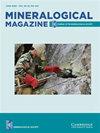首次出现M2a2b2c多型银多碱矿[Ag6Sb2S7][Ag10S4]:磷铝石-多碱矿群无铜成员的结构调整
IF 1.4
3区 地球科学
Q2 MINERALOGY
引用次数: 0
摘要
摘要通过对加拿大安大略省Timiskaming地区的Gowganda和加利福尼亚州Alpine县银山矿区的IXL矿这两个新发现的矿物的研究,对最近描述的矿物argentopolybasite的化学和晶体结构进行了详细的讨论。阿根廷多基岩的晶体结构可以描述为沿c轴的两个交替层序:a [Ag6Sb2S7]2 - a层和a [Ag10S4]2+ B层。在B层中存在线性配位的金属位置(B位),在珠光-多基岩族的所有成员中通常被铜占据,形成B层成分[Ag9CuS4]2+。然而,在阿根廷多基岩中,Ag填充了A层和B层的所有金属位点。利用电子探针和单晶x射线衍射对67个珠光-多基岩类样品进行了多元回归分析,模拟了Ag、Sb和Se对B层B位的影响。虽然这些矿物的命名规则仅基于化学数据,但我们认为这种方法有助于评估结构的细化程度(Ag/Cu无序),从而为区分珠光-多基岩群的不同成员奠定基础。本文章由计算机程序翻译,如有差异,请以英文原文为准。
First occurrence of the M2a2b2c polytype of argentopolybasite, [Ag6Sb2S7][Ag10S4]: Structural adjustments in the Cu-free member of the pearceite–polybasite group
Abstract The chemistry and the crystal structure of the recently described mineral argentopolybasite are critically discussed based on the study of two new occurrences of the mineral: Gowganda, Timiskaming District, Ontario, Canada and IXL Mine, Silver Mountain mining district, Alpine County, California. The crystal structure of argentopolybasite can be described as the sequence, along the c axis, of two alternating layers: a [Ag6Sb2S7]2– A layer and a [Ag10S4]2+ B layer. In the B layer there are linearly-coordinated metal positions (B sites), which are usually occupied by copper in all members of the pearceite–polybasite group, resulting in a B-layer composition [Ag9CuS4]2+. In argentopolybasite, however, Ag fills all the metal sites in both A and B layers. By means of a multi-regression analysis on 67 samples of the pearceite–polybasite group, which were studied by electron microprobe and single-crystal X-ray diffraction, the effect of Ag, Sb and Se on the B sites of the B layer was modelled. Although the nomenclature rules for these minerals are based on chemical data only, we think this approach is useful to evaluate the goodness of the refinement of the structure (Ag/Cu disorder) and thus fundamental to discriminate different members of the pearceite–polybasite group.
求助全文
通过发布文献求助,成功后即可免费获取论文全文。
去求助
来源期刊

Mineralogical Magazine
地学-矿物学
CiteScore
4.00
自引率
25.90%
发文量
104
审稿时长
6-12 weeks
期刊介绍:
Mineralogical Magazine is an international journal of mineral sciences which covers the fields of mineralogy, crystallography, geochemistry, petrology, environmental geology and economic geology. The journal has been published continuously since the founding of the Mineralogical Society of Great Britain and Ireland in 1876 and is a leading journal in its field.
 求助内容:
求助内容: 应助结果提醒方式:
应助结果提醒方式:


